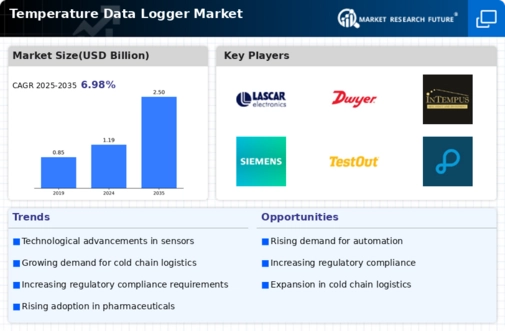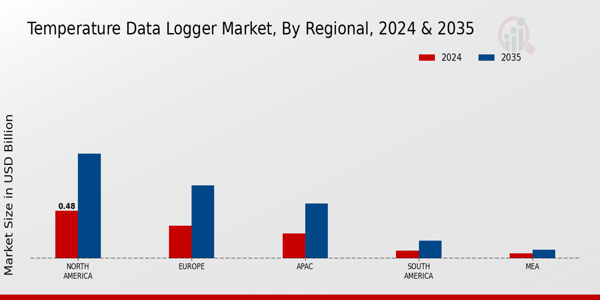Market Growth Projections
The Global Temperature Data Logger Market Industry is projected to experience substantial growth, with estimates indicating a market value of 1.19 USD Billion in 2024 and a potential increase to 2.5 USD Billion by 2035. This growth trajectory suggests a compound annual growth rate of 6.98% from 2025 to 2035. Such projections highlight the increasing reliance on temperature data loggers across various sectors, driven by technological advancements, regulatory compliance, and heightened awareness of product safety. The market's expansion reflects the critical role of temperature monitoring in ensuring quality and safety in temperature-sensitive applications.
Growth of the E-commerce Sector
The expansion of the e-commerce sector significantly influences the Global Temperature Data Logger Market Industry. As online shopping continues to gain traction, the demand for efficient cold chain logistics increases. E-commerce companies require robust temperature monitoring solutions to ensure that perishable goods are delivered in optimal conditions. This trend is particularly evident in the food and beverage sector, where maintaining the cold chain is critical to prevent spoilage. The growing reliance on temperature data loggers in e-commerce logistics is expected to contribute to the market's growth, aligning with the projected increase in market value over the coming years.
Rising Awareness of Food Safety
The heightened awareness of food safety among consumers serves as a crucial driver for the Global Temperature Data Logger Market Industry. With increasing concerns about foodborne illnesses, stakeholders in the food supply chain are prioritizing temperature control to ensure product safety. Regulatory bodies are also emphasizing the importance of temperature monitoring in food storage and transportation. This growing awareness compels food manufacturers and distributors to adopt advanced temperature data logging solutions to comply with safety standards. As a result, the market is likely to experience sustained growth, reflecting the critical role of temperature data loggers in safeguarding public health.
Increasing Regulatory Compliance
Regulatory compliance is a significant driver in the Global Temperature Data Logger Market Industry, particularly in sectors such as healthcare and food safety. Governments worldwide are implementing stringent regulations to ensure that temperature-sensitive products are stored and transported under controlled conditions. For example, the FDA mandates specific temperature ranges for pharmaceuticals during storage and transport. This regulatory landscape compels companies to invest in reliable temperature data logging solutions to avoid penalties and ensure product integrity. Consequently, the market is poised for growth, with projections indicating a rise to 2.5 USD Billion by 2035.
Rising Demand for Temperature Monitoring
The Global Temperature Data Logger Market Industry experiences a notable increase in demand for temperature monitoring solutions across various sectors, including pharmaceuticals, food and beverage, and logistics. This demand is driven by the necessity for compliance with stringent regulations regarding temperature-sensitive products. For instance, the pharmaceutical industry requires precise temperature control to ensure drug efficacy. As of 2024, the market is projected to reach 1.19 USD Billion, reflecting the growing awareness of the importance of temperature monitoring in maintaining product quality and safety.
Technological Advancements in Data Logging
Technological advancements play a pivotal role in shaping the Global Temperature Data Logger Market Industry. Innovations such as wireless connectivity, cloud-based data storage, and real-time monitoring capabilities enhance the functionality of temperature data loggers. These advancements facilitate seamless data access and analysis, which is crucial for industries that rely on accurate temperature tracking. The integration of IoT technology further enhances the appeal of these devices, allowing for remote monitoring and alerts. As a result, the market is expected to witness a compound annual growth rate of 6.98% from 2025 to 2035, indicating a robust growth trajectory.
























